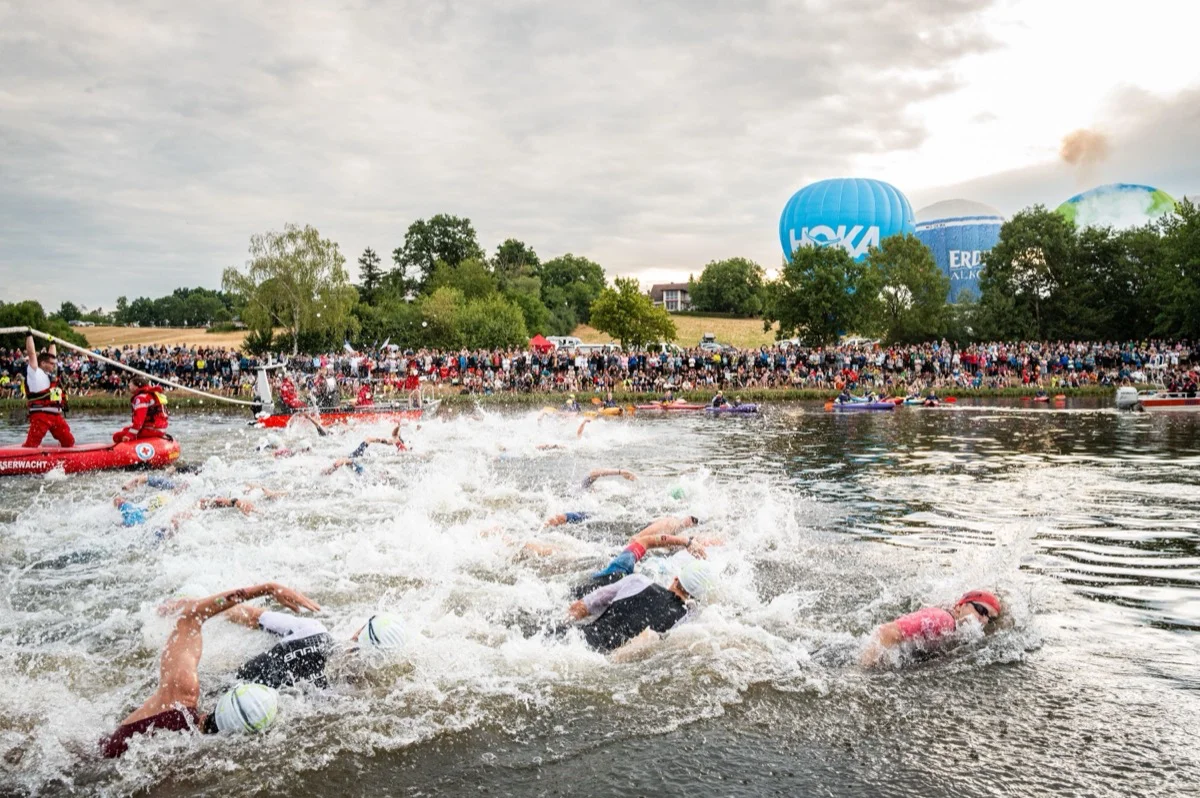Learn Freestyle Swimming: Basics and Movement Sequence
To swim quickly and efficiently in the freestyle position, you need not only good body position in the water but also solid technique in the stroke. Learning this as an adult is more difficult than in childhood, and achieving an extremely high performance level is unlikely. Nevertheless, even at a more advanced age, an efficient swimming technique can still be developed.
The German Swimming Federation (DSV) identifies 6 key elements for a clean basic freestyle technique. We will present these 6 elements in detail below. We also highlight aspects that a coach or you yourself should observe in your technique. It can be helpful to film yourself while swimming (Note! Always only after consulting the lifeguard).
The 6 elements of clean freestyle technique (according to DSV)
1. Body Position & Water Position
- Straight body posture
- Stable head position in line with the spine
- Head, shoulders, hips, and heels close to the water surface
- Slightly angled upper body
- Continuity throughout the movement cycle
Special attention should be paid to ensuring the back third of the head is above the water surface. The forehead should be in the water and the gaze directed toward the bottom. The hips should be just below the water surface. This requires good core tension. It can help to imagine pulling the navel toward the center of your body. Common mistakes include a head that is too high, too low, or unstable, moving side to side. Additionally, undulating movements of the entire body are frequent and undesirable.
2. Rotation Around the Longitudinal Axis
- Alternating and even shoulder rotation along the body axis
- Stable hip position
- Even rotation maintained during inhalation
The even rotation with a stable hip should be clearly visible. A stable hip does not mean rigid and horizontal; it should move stably, slightly relative to the body. Overall, the hip should be stable to avoid undulating movements and excessive rotation.
Common errors include uneven, too little, or too strong rotation.
3. Leg Kick in Freestyle
- Alternating • continuous • whip-like
- Downward and upward strokes with equal intensity
- Impulse comes from the hips
Feet:
- Relaxed and slightly turned inward
- Overextended on the downward stroke
- Extended on the upward stroke
- Foot breaks the water surface on the upward stroke
Special attention should be paid to the correct impulse initiation in the hips. The impulse continues in a whip-like motion down the leg. A useful analogy is swimming with fins while snorkeling: the leg generates the impulse, and the fin snaps behind, transferring the impulse into the water. The lower leg follows this principle in freestyle kick.
Common mistakes are interrupted leg movements, impulse starting in the knee so that only the lower leg moves, and not breaking the water surface on the upward stroke.
4. Breathing in Freestyle
- Continuous and complete exhalation underwater (through mouth and nose)
- Inhalation through the mouth
- Head rotates around the body axis to the side to inhale
- Arm movement rhythm maintained during inhalation
Breathing rhythm is particularly important. Swimmers often train a one-sided breathing pattern for years. If waves come from that side in a race, the technique collapses because they cannot breathe to the other side. Therefore, training should include breathing on both sides.
Some swimmers boast that they only breathe every 5 or 6 strokes (= 5- or 6-stroke breathing). They often overlook that this deprives the body of oxygen and can limit performance. The goal should be to maintain clean technique even with 2-stroke breathing to supply the body continuously with oxygen.
Common mistakes: incomplete exhalation underwater, combined side rotation and head lifting, extended pause between strokes, loss of speed.
{{cta}}
5. Arm Stroke in Freestyle
The arm movement can be broken down into three phases:
- Entry & catch
- Pull & push
- Recovery
1. Entry & Catch [1-3]
- Low-resistance entry in line with body axis
- Full arm extension just below the water surface
- Slight angling of hand and forearm (“catch”) just below the water surface
Observation points: splash-free hand entry, full arm extension just below water. Crucial technique element: high elbow / angling hand and forearm, arm nearly vertical in the water. Upper arm rotates internally at the shoulder to optimally transfer force in the pull & push phase.
Common mistakes: overreaching with the hand, early arm drop before the catch, limited shoulder mobility.
2. Pull & Push Phase [3-6]
- Elbow lead
- Long push to the thigh
- Hand as long as possible perpendicular to pool bottom
- Accelerate arm and hand until the end of the push phase
Good visualization: we don’t move the arm through the water; instead, we fix the arm and accelerate the body past it (like between rungs of a horizontal wall).
Common mistakes: releasing elbow lead too early, too short push phase, hand comes out of the water before/at hip height.
3. Recovery Phase [7]
- Low-resistance and relaxed arm recovery
- High elbow
Important: consciously relaxed recovery, propulsion muscles as relaxed as possible. Common mistakes: dragging the hand through the water forward, flinging the straight arm back, both causing loss of force and affecting body position.
6. Coordination & Rhythm
- 6-beat kick (maintain rhythm during inhalation)
- 3-stroke breathing (smoothly integrated into arm movement)
Good coordination of arms and legs leads to smoother, faster freestyle. The DSV recommends a 6-beat kick and 3-stroke breathing. For swimmers with inefficient kicks, a 6-beat kick may cause excessive fatigue. Individualized training is recommended, e.g., small pyramid blocks in swim training (e.g., 11×50 m: 1-beat → 6-beat → descending).
Typical freestyle swimming mistakes and how to avoid them


.webp)
